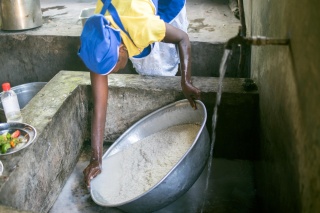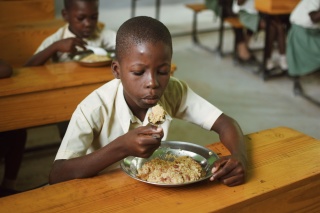
Haiti
Since 2006, Mary’s Meals has been supporting the children of Haiti – one of the most disadvantaged and extreme-weather affected countries in the world
Published onHaiti, ranking 170 out of 189 countries in the Human Development Index (HDI), is one of the poorest nations on earth. It is the only low-income country in the Americas and ranks fourth on the 2019 Climate Risk Index for countries most affected by extreme weather events. Malnutrition is widespread owing to chronic food insecurity and a persistent onslaught of natural disasters has ravaged the nations’ inhabitants of the ability to sustain a livelihood.
24.5% of the population are living below the International Poverty line ($1.90 per day) and around 49% of the general population is undernourished. More than half a million children in Haiti are out of school.
Life in Haiti
Haiti, the most populous country in the Caribbean – with around 11.4 million inhabitants – is located in North America, on the island of Hispaniola. Haiti shares the island with the Dominican Republic and is 27,750 square kilometres in size, meaning it is also the third largest country in the Caribbean by area.
The Haitian Revolution has often been described as the largest and most successful slave rebellion in the Western Hemisphere. Slaves initiated the rebellion in 1791 and by 1803, had succeeded in ending, not just slavery, but French control over the colony.
On January 1, 1804, Jean-Jacques Dessalines, a leader of the Haitian Revolution, declared the nation independent and renamed it from ‘Saint Dominigue’, to Haiti, becoming the first ruler of an independent Haiti in the process. France became the first nation to recognise its independence.
A magnitude 7.0 earthquake struck Haiti on the afternoon of January 12, 2010, causing the country to face one of the greatest humanitarian crises in history. The earthquake was devastating, killing around 250,000 people and injuring 300,000 more. It caused the displacement of roughly 5 million people and some 4,000 schools were damaged or destroyed.
A decade later and Haiti is still struggling to recover from the disaster. Some parts of the country that were destroyed in 2010 have yet to be rebuilt and there is little sign that buildings which have been reconstructed are structurally sound enough to keep inhabitants safe through the next inevitable extreme-weather event.
Political instability, food shortages, unemployment, tropical storms and hurricanes have kept most Haitians locked in a cycle of poverty for generations.
Mary's Meals in Haiti
Mary’s Meals has been providing meals in Haiti since 2006. We work with four local partners to deliver our school feeding programme in Haiti – Caritas Hinche, Summits Education, Hands Together and BND (Bureau de Nutrition et Développement).
We work to support children in the remote and under-developed Central Plateau Region, as well as in high-risk urban slum areas in Gonaïves and in the capital, Port-au-Prince.
We are currently feeding 99,328 in 293 schools in Haiti.
- When did we start working in Haiti?
We have been working in Haiti since 2006
- How many children do we feed in Haiti?
We are currently feeding 99,328 in 293 schools in Haiti
- What meal do we provide?
maize and beans, or rice and beans with fish
- Where are we based/where do we operate?
Central Plateau Region, as well as in high-risk urban slum areas in Gonaïves and in the capital, Port-au-Prince.
- Capital City
Port-au-Prince
- Population
11.4 million
- Currency
Haitian Gourde (HTG G)

